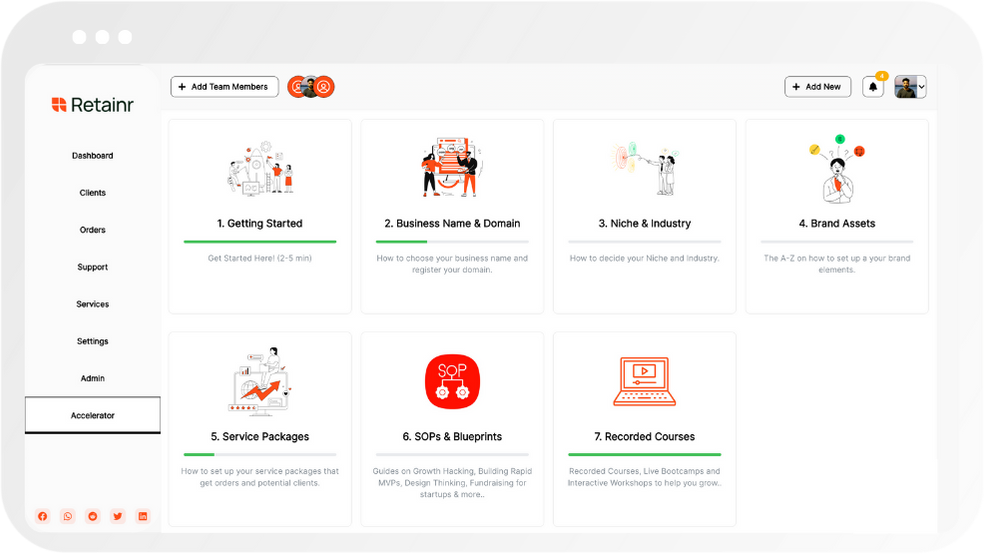
10 Steps to a Successful Social Media Strategy
Build with Retainr
Sell your products and services, manage clients, orders, payments, automate your client onboarding and management with your own branded web application.
Get Started1. What are the 10 steps to a successful social media strategy?
Understanding the Steps
Creating a robust and successful social media strategy involves a few crucial steps. Firstly, set clear and attainable goals that align with your business objectives. Secondly, understand your audience; this entails creating audience personas and discovering their needs, tastes, and interests. Thirdly, conduct a competitive analysis to determine what your competitors are doing right, and where they're going wrong. Additionally, determine the appropriate social media platforms that align with where your target audience spends most of their time.
Execution and Measurement
The next set of steps involves execution and measurement. Create engaging content that adds value to your followers, tailoring it for each social media platform. Next, establish a content calendar to maintain consistency in your posts. Then, engage with your audience regularly; reply to comments, join in discussions, and be active in social conversations.
Analyzing Success
Finally, measure your results using the available analytics tools on each platform. Adjust your strategy if need be to achieve better results. Lastly, stay updated with the latest social media trends and tactics to maintain your strategy's relevance.
| Step | Action |
|---|---|
| 1 | Establishing Goals |
| 2 | Understanding your audience |
| 3 | Conducting competitive analysis |
| 4 | Selecting appropriate platforms |
| 5 | Creating engaging content |
| 6 | Establishing a content calendar |
| 7 | Engaging with your audience |
| 8 | Measuring results |
| 9 | Adjusting strategy |
| 10 | Keeping up with trends |
2. Why is having a social media strategy important for my business?
Importance of Social Media Strategy
Having a well-defined social media strategy is crucial for the growth and development of your business. Firstly, social media provides a platform for businesses to reach a larger and more diverse audience. This enables you to promote your products or services, build your brand’s presence, and engage with potential customers. Secondly, a strong social media strategy allows you to stay relevant in today's digital era. In a rapidly evolving market, businesses need to adapt and keep pace with their consumers' behavior and preferences, and social media is an effective medium to do so.
| Benefits | Description |
| Brand Awareness | Through regular posts, potential customers can easily recognize your brand. |
| Customer Engagement | Create a direct line of communication with your consumers and generate feedback. |
| Increased Traffic | Utilize your social platforms to direct users to your website. |
| Improved SEO | Through social media, you can boost your website's search engine ranking. |
Lastly, a well-crafted social media strategy can increase your ROI. Not only can social media lead to a surge in website traffic, it can also effectively increase your sales and revenue. By targeting a specific demographic based on their online behavior, social media helps you optimize your marketing budget and ensure your marketing efforts lead to meaningful results.
3. How can I better define my audience as a part of my social media strategy?
Understanding your Audience
Defining your audience is a critical step in developing a successful social media strategy. You need to know who you're targeting, where they hang out online, their interests, behaviours, and what kind of content they engage with. To start, you can develop user personas. You can categorize them based on demographics such as:
| Age | Gender | Location | Occupation | Income |
|---|---|---|---|---|
| 18-24 | Female | New York | Student | $30,000 |
| 25-34 | Male | Chicago | Entrepreneur | $70,000 |
Researching your Audience
You may have a general idea of your target audience, but research is vital to deepen this understanding. Social media platforms provide analytics tools that can give you insight into your audience's behaviour. Learning about their preferences, online activity periods, and content consumption habits can optimise your strategy. You can also interact with them directly via surveys and polls to gather feedback. A list of some useful tools:
- Facebook Insights
- Twitter Analytics
- Instagram Insights
- LinkedIn Page Analytics
Creating Relevant Content
Once you know your audience, the next step is to create content that resonates with them. If your audience is young and hip, they may prefer visual content like infographics or videos. A more professional audience may appreciate in-depth articles and whitepapers. Here are some content types to consider:
- Videos
- Infographics
- Blogs and Articles
- Whitepapers and e-books
- Podcasts
4. Who is responsible for the content creation in a social media strategy?
Responsibility of Content Creation in a Social Media Strategy
The success of a social media strategy primarily revolves around high-quality and engaging content. Therefore, identifying 'who' is responsible for content creation is crucial. This role often falls into the hands of a Content Creator, a Marketing Specialist or a Digital Marketing Manager with experience in social media.
Different people responsible for content creation can vary depending on the size and nature of the organization. Here is a brief role description of each potential stakeholder:
- Content Creator - The primary responsibility is crafting content for various social platforms, ensuring it's engaging, aligns with the brand voice, and encourages audience interaction.
- Marketing Specialist - They are responsible for planning and executing marketing campaigns. A portion of their duty may involve creating or overseeing content creation.
- Digital Marketing Manager - They typically oversee the entire online marketing strategy, which includes overseeing the content creation process, ensuring it aligns with the larger marketing goals.
Team Structure for Content Creation
Below is an example of a typical team structure for content creation, covering various roles and responsibilities. The specific structure can differ based on the organizational setup and needs:
| Role | Responsibility |
|---|---|
| Content Creator | Create, edit, proofread content for social platforms |
| Marketing Specialist | Plan, execute and coordinate marketing campaigns |
| Digital Marketing Manager | Oversee the whole digital marketing strategy including content creation |
Importance of Clear Role Definition
Maintaining a clear role definition among the key stakeholders not only streamlines the content creation process but also helps to achieve the social media goals effectively. It ensures that each person involved knows their specific tasks, deadlines, and is accountable for their work. Collaborative efforts guided towards a common goal can pave the way for a successful social media strategy.
5. How frequently should I post on social media as part of my strategy?
Frequency of Posting
When deciding on the frequency of your social media posting, it's essential to consider the type of content you create, the social media platforms you use, and your target audience. One thing to keep in mind is that the aim is not to spam your followers but to provide engaging and valuable content.
Recommended Posting Frequencies
Here's a general guideline you can follow for each platform, but remember to adjust based on your audience engagement:
- Facebook: Once or twice per day
- Instagram: Once per day
- Twitter: Three to seven tweets per day
- LinkedIn: Once or twice per week
Posting Schedule
Keep track of the best times to post on social media, which can fluctuate depending on the specific platform and your audience. Use the following table as a baseline to determine the optimal posting times:
| Best Times | 10-11 AM | 9 AM - 3 PM | 11 AM - 2 PM | 7-8:30 AM, 5-6 PM |
| Peak Times | 11 AM - 2 PM | 12-1 PM | 11 AM - 1 PM | 7 AM, 12 PM, 5 PM |
6. How can I measure the success of my social media strategy?
Setting Key Performance Indicators
Your social media strategy's success can be measured by setting Key Performance Indicators (KPIs). KPIs are specific and quantifiable parameters that can reveal whether the social media channels are meeting your business objectives. They depend on your organization's goals, however, common KPIs include followers count, likes, comments, shares, click-through rates, impressions, and conversations started.
Utilizing Social Media Analytics Tools
Several tools can help you measure the success of your social media strategy. These include native analytics such as Facebook Insights and Twitter Analytics, and third-party tools like Hootsuite and Sprout Social among others. These tools can provide in-depth analysis on your social media performance including the best time to post, the type of content that trends, demographic information of followers, conversation analysis, and sentiment analysis among many others. Here is a table showing some common analytics tools and their features:
| Tool | Features |
|---|---|
| Facebook Insights | Page likes, post reach, engagement |
| Twitter Analytics | Tweets, Tweet impressions, profile visits |
| Hootsuite | Scheduling, monitoring, analytics |
| Sprout Social | Engagement, publishing, listening |
Conducting a Social Media Audit
Finally, you can measure your strategy's success by conducting a social media audit. An audit involves systematic examination of social media data to help marketers discover, categorize, and evaluate all the social media channels that represent a company or brand. It helps in understanding what's working, what's failing and what can be improved upon across your social media channels. Your audit should determine the channels driving the most traffic, which updates result in the most engagement, and evaluate the frequency and type of content posted.
7. What are the common mistakes to avoid when developing a social media strategy?
Common Mistakes to Avoid When Developing a Social Media Strategy
Creating a powerful social media strategy is crucial to your business's success; however, there are several common mistakes that many companies often fall victim to. Avoiding these pitfalls can mean the difference between a successful campaign and a failed one.
The first common mistake is to lack a clear and measurable goal. Without a definite objective, you cannot gauge the success of your efforts. This flaw can be avoided by setting SMART (Specific, Measurable, Achievable, Relevant, and Time-bound) goals. Second, many companies do not understand their target audience well. To avoid this, research your audience thoroughly, understand their needs, wants, and inclinations and tailor your content accordingly. Third, using all social media platforms without considering if they are suitable for your business and audience is another misstep. Select your platforms based on your audience's preferences.
| Mistake | Correction |
|---|---|
| Absence of clear and measurable goals | Set SMART goals |
| Lack of understanding of target audience | Conduct audience research |
| Using all and any social media platform | Choose platforms that suit your business and target audience |
In addition, avoid being too promotional. Instead of ceaseless self-promotion, provide informative, entertaining, or inspiring content that adds value to your audience. Lastly, many businesses fail to track and measure their results, losing the opportunity to optimize their strategy based on performance metrics. It is vital to make regular assessment and subsequent strategy adjustments.
8. How should I adapt the strategy for different social media platforms?
Understanding Individual Platform
Each social media platform has its unique audience, and the strategy should be adapted accordingly. For platforms such as Instagram and Pinterest which are image-centric, high-quality photos and infographics should be your go-to content. Twitter, on the other hand, is suitable for sharing quick updates, news or thoughts. LinkedIn is fantastic for showcasing company achievements and job openings while Facebook can be used for a variety of content including articles, videos, photos, and more:
| Platform | Content Strategy |
|---|---|
| Instagram, Pinterest | High-quality photos and infographics |
| Quick updates, news or thoughts | |
| Company achievements, job openings | |
| Variety of content including articles, videos, photos |
Creating Platform-Specific Goals
It's equally important to identify platform-specific goals. Here are a few examples:
- Instagram: Boost brand awareness, improve audience engagement
- Pinterest: Drive website traffic, showcase products
- Twitter: Improve customer service, share breaking news
- LinkedIn: Recruit new employees, establish industry thought leadership
- Facebook: Build community, increase website traffic
Developing Platform-Specific Metrics
Last but not the least, developing platform-specific metrics is crucial for evaluating the performance of each platform and tweaking your strategy as needed. Some of these metrics might include:
- Instagram: Followers growth, engagement rate, clicks to website
- Pinterest: Pin saves, click-through rate, impressions
- Twitter: Tweet impressions, retweets, mentions
- LinkedIn: Post impressions, clicks, likes, shares
- Facebook: Page likes, post reach, engagement rate
9. What roles do analytics and metrics play in a successful social media strategy?
The Role of Analytics in Social Media Strategy
Analytics play a critical role in an effective social media strategy. They allow you to measure the performance and effectiveness of your digital marketing efforts. This helps in understanding your audience, their behaviors, and their engagement patterns. Without these insights, optimal utilization of social media campaigns is close to impossibility.
- Analytics enable you to identify the best performing content.
- Allow you to see macro-level and detailed-level trends.
- They help you determine the prime time to post, ensuring maximum engagement.
- Analytics assist you in identifying key influencers in your network.
The Role of Metrics in Social Media Strategy
Metrics, on the other hand, provide a detailed and quantifiable measure of your social media performance. They offer fundamental insights that can support decision-making processes and contribute to the evolution of your strategy. They show you what's working, what's not and where the opportunities for improvement lie.
| Metric | Description |
|---|---|
| Reach | Number of potential unique viewers your post has reached. |
| Engagement | Number of people who have engaged with your content. |
| Page Views | Number of times your profile or page was viewed. |
Conclusion
In summary, analytics and metrics are the backbone of any successful social media strategy. While analytics give you an understanding of your audience and their behavior, metrics provide the details needed to assess the performance and measure the success of your social media activity. Therefore, constant monitoring, learning from the insights, and adapting your social media strategy accordingly is essential for achieving your marketing goals.
10. What are some tools and resources that can help me improve my social media strategy?
Essential Tools and Resources for Improving Social Media Strategy
There are several tools, applications, and resources available that can significantly enhance your social media strategy. Noteworthy ones include:
- Buffer: This is a powerful social media management tool that allows you to schedule posts across different platforms ahead of time.
- Canva: Canva is a free graphic design tool that you can use to create engaging visual content for your social media.
- Google Analytics: It is an analytical tool that provides in-depth insights about your audience which can be used to refine your strategy.
- Bitly: Bitly helps to shorten, brand, and optimize links for social posts to track individual link analytics.
- SocialOomph: This is a scheduling tool with a raft of features designed to boost your productivity on social media.
- BuzzSumo: It is a search tool that tracks content on all social networking sites and ranks them based on the number of shares.
More Resources to Improve Your Social Media Strategy
In addition, there are many resources available online which can offer valuable insights to fine-tune your strategy:
- Social Media Examiner: Provides original and detailed articles, expert interviews, original research, and the news you need to improve your social media marketing.
- Sprout Social Insights: Here, you'll find articles, guides, infographics, and webinars all aimed at helping you develop your social media strategy.
- Hootsuite Blog: This blog offers a treasure trove of articles on every aspect of social media marketing.
Comparison of Key Features of Social Media Tools
| Social Media Tool | Key Features |
|---|---|
| Buffer | Social Post Scheduling, Analytics, Multiple Account Management |
| Canva | Graphic Design, Social Post Templates, Collaborative Features |
| Google Analytics | Audience Insight, User Behavior Tracking, Custom Reports, Integration with other Google services |
Conclusion
Build a Successful Social Media Strategy in 10 Easy Steps
Creating a successful social media strategy is a critical component for any business wishing to build a strong online presence. To simplify the process, we've outlined 10 steps to help you create a robust and effective social media plan.
1. Set Social Media Goals
Identify what you want to achieve with your social media efforts. Whether it's increasing brand awareness, driving sales, or improving customer engagement, having clear goals will guide your strategy.
2. Identify Your Target Audience
Understanding who your audience is essential. Learn about their demographics, interests, and online behavior to create content that resonates with them.
3. Choose the Right Platforms
Focus on platforms where your target audience spends their time. Each platform attracts a different type of audience and requires a unique approach.
4. Develop Your Brand’s Voice
Your brand’s voice should be consistent on all social media platforms. This helps establish brand identity and creates a more personal connection with your audience.
5. Plan and Create Content
Content is king in social media. Establish a content calendar to regularly post engaging and valuable content for your audience.
6. Implement a Social Media Management Tool
Use a tool like Retainr.io to efficiently manage all your social media activities. This whitelabel software enables you to sell, manage clients, orders, and payments with your own branded app.
7. Engage with your Audience
Foster relationships with your audience by responding to comments, answering messages, and regularly interacting with them.
8. Measure and Analyze Performance
A robust social media strategy involves tracking and analyzing key metrics. Learn from these insights to optimize your strategy over time.
9. Experiment and Tweak Your Strategy
Don’t be afraid to try new things in your strategy. Keep an eye on new trends, innovations, and shifts in the social media landscape.
10. Repeat and Refine
Constantly review and enhance your strategy based on the results and feedback from your audience.
In the fast-paced world of social media, strategies can quickly become outdated. But with a solid plan and the help of sophisticated management tools like Retainr.io, you can stay ahead of the curve and achieve your social media objectives.
Boost Your Agency Growth
with Retainr Accelerator
Uncover secrets, strategies, and exclusive blueprints to take your agency's growth to the next level — from marketing insights to effective presentations and leveraging technology.

SOPs, Cheatsheets & Blueprints
Leverage 50+ SOPs (valued over $10K) offering practical guides, scripts, tools, hacks, templates, and cheat sheets to fast-track your startup's growth.
Connect with fellow entrepreneurs, share experiences, and get expert insights within our exclusive Facebook community.
.jpg)

Join a thriving community of growth hackers. Network, collaborate, and learn from like-minded entrepreneurs on a lifelong journey to success.

Gain expertise with recorded Courses, Live Bootcamps and interactive Workshops on topics like growth hacking, copywriting, no-code funnel building, performance marketing and more, taught by seasoned coaches & industry experts.

.jpg)

.jpeg)


